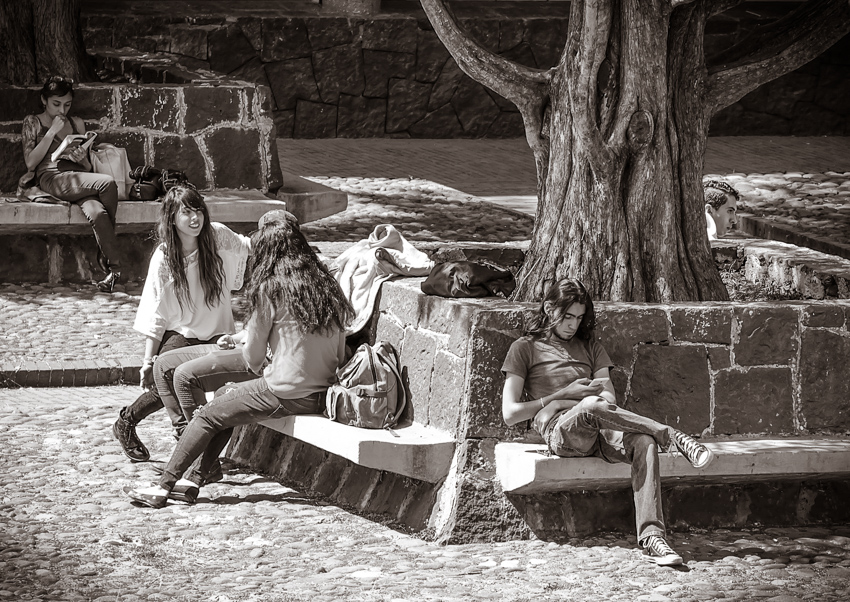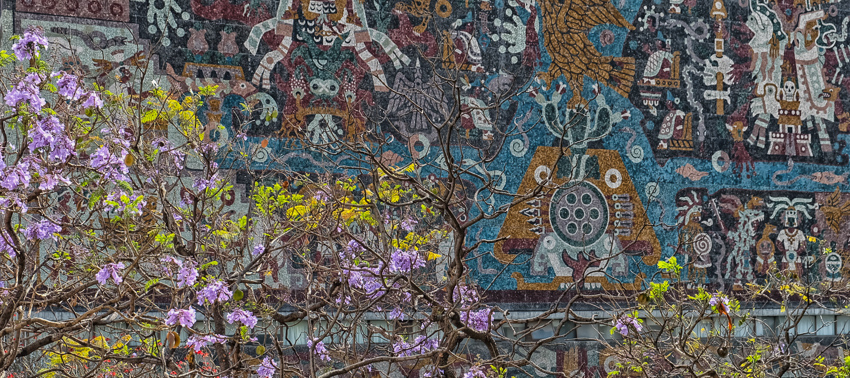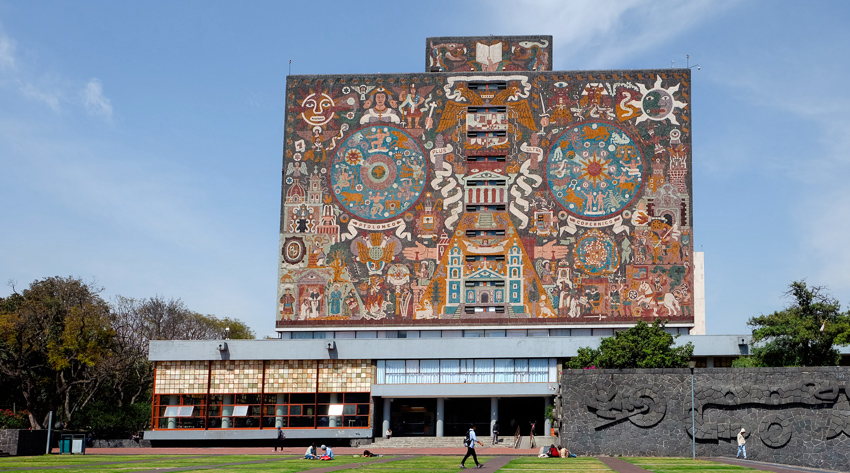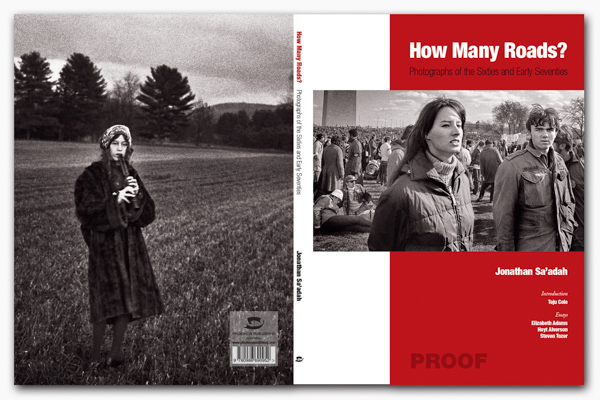
Students reading and talking In the southern part of Mexico City, the Universidad Nacional Autónoma de México (UNAM) is a 425,000 student campus with many departments. Its graduates form a backbone of recent Mexican history. The current campus replaced a metropolitan location in the 1950s, but the school traces its lineage back to 1551.
I’m not as big a recreational reader as I’d like to be. I’m not that fast a reader and I feel like after I’ve waded through all the web and print articles and news reports I’m interested in there isn’t a lot of extra time left over. But before going to Mexico City I set a goal of reading several books about the city and Mexico, and one of them was Savage Detectives by Roberto Bolaño. I have a hard time understanding why this book isn’t generally known and acknowledged to be one of the great novels of the 20th century. Bolaño, a Chilean who lived mostly in Mexico City and Barcelona, was an enfant terrible of the literary world and a complicated, evocative writer. I haven’t read his masterpiece 2666 yet, but I’m looking forward to it.

The outside surfaces of the university library are covered with a wrap-around mural by Juan O’Gorman depicting different periods of Mexican history. The generally huge scale of the campus is home to other building-sized murals.
Savage Detectives is mostly set in Mexico City and strings together a story of a group of young scruffy Mexican poets searching for a woman (Cesárea Tinajero) who had disappeared from the city several decades before. They considered her to be the mother of Visceral Realism, their faction of the Mexican poetry world. In a complex weave the story line touches many subplots, and one of them involves a character who is a Uruguayan female poet and teacher named Auxilio Lacouture.
Auxilio Lacouture taught at the Universidad Nacional Autónoma de México (UNAM) for several years. According to her own narrative, she was not quite sure what those years were, but one event fixes her as being there in 1968. That event was the Mexican army and riot police killing an unknown number of students in Tlatelolco, a section of Mexico City. A sadly familiar story having a contemporary ring.
Subsequently, the Army occupied UNAM.
Auxilio Lacouture had the distinction of spending thirteen days in September of 1968 shut up in the women’s bathroom on the fourth floor of the Faculty of Philosophy and Literature as a protest against the Army’s occupation of the campus. She had been reading a book of poetry of Pedro Garfías in a toilet stall and simply stayed there undiscovered – alone and stubborn – standing up (or sitting down!) against tanks and militarism until they left thirteen days later.
I thought it would be interesting to go to UNAM and see if I could find the her fourth floor perch. I was also interested because our friend, Magda, had gone to Medical School there and I wanted to see where she had spent that time.

A more conventional look at the unconventional exterior of the central university library. The mural wraps around all four sides.
UNAM is a huge campus – there are almost 400,000 students. To be a student there involves a lot of competition and carries prestige. UNAM reflects both a tradition of academic freedom and social activism that seems part of Mexico.
The feeling on campus was not especially comfortable for me. It was obvious that I was an outsider, as well as being several decades older than almost everyone we saw.
We tracked down the building and floor that Auxilio had been in. A narrow staircase led to the fourth floor. A small – almost claustrophobic – hallway formed a central corridor with many closed wooden doors. The interesting fact was that no one save one student had heard of Roberto Bolaño, and on the subject of Auxilio Lacouture – a complete blank. We found a locked women’s bathroom, but the closest we got to Auxilio’s memory were raised eyebrows as an adult staff member and secretary Googled her. A picture of me outside the bathroom was on the phone stolen later in the day on the Metrobus. It really doesn’t matter to me that Auxilio Lacouture never actually existed. She was fashioned after a real person who was at UNAM (Alcira Soust Scaffo), herself a Uruguayan poet. Considering the position of both Bolaño as a writer and Savages as a book, there should have been no hesitation recognizing him as a writer and Lacouture as a character …
I’m not sure what all of this says. A friend in Montreal who is from South America said it’s typical in Columbia, where she grew up, for the government to eradicate memory. This may be an example of that same phenomena in Mexico.
Sometimes, I have to admit, I feel the same way about the 1960s here.



We are so limited in our outlook. I am happy for this glimpse of a world I can never enter.
Looking at that photo again, I am haunted by the faces of the girls and wonder what will become of them.
People are reading it, young people it was recommended to me by a University student in Queretaro..What a wild and fantastic read..Not having been in DF in a few years I appreciated the distinct flavour of the characters and the line of the story. Going to meet in bars and book stores all over the city..
I agree with Sam and wonder if our sense is affected by (how to say this) our age and stage re who reads what. I am eager to hear how you respond to 2666. Don’t worry about your reading habits, for me the thing is to begin and then be absorbed or put the book down.
It is still being read in 2024! I am sharing this delicious book with my Mexicana wife, who lived for more than four decades in DF. Though she came of age a little later than Belaño’s young poets, she knows well the people and places that inform the story. I’m sure we’re not alone, because a few days ago I stumbled upon a posting to arstechnica.com under the handle “VisceralRealist.”
Ironically, I just was in Mexico City for two weeks – my first trip back there since covid. I hope your wife takes you back, and often. Being there as a tourist is different from having a real connection, though this is the seventh visit for me, and I envy you. Though Bolaño wrote the book a while ago I’m sure he’d be pleased that I still feel him in the city as, I’m sure, you would too. Thanks for writing.
I realize this is an old post but our Ethnic Literature class is reading Savage Detectives and we just finished reading about Auxilio Lacouture. We are going to steal your idea of “mapping” the book by picking a location we want to go find and experience for ourselves. I am using your example to model for my students. Auxilio’s experience helps answer our question about what this book shows us regarding Mexico City in the 60s and 70s. Auxillo’s bathroom shelter demonstrates the fear of revolution felt by those wanting to maintain the order of things and the fear of the putting down of the revolution felt by those “visceral realists”. Finally, when Auxillio speaks of the link between writing and destruction and hiding and being found she is telling us what her true discovery, her “epiphany of Mexico” is, having been stuck in that bathroom: writing is a way of making oneself absent. To destroy one’s writing is an act of exposing one’s self. To resist is to write, to read is to learn how to hide.
Hi Ian – When I go on the UNAM campus now I’m sure I look like an old man to the young students there, but regardless I don’t feel that way and Vietnam was also a period where campuses were under attack. Now it’s even more toxic what’s happening. Savage Detectives would be a rich environment for a lot of discussions. In some ways, as terrible as it sounds, I might rather have tanks outside to what’s happening presently in the US. When I look back on Vietnam it was the National Guard, but the idea was the same. You don’t say where you are located but I hope you’re having good discussions with your students. I’ve actually been working on resurrecting this blog, and plan to have new posts soon. I hope you will check back!
I find it compelling that Bolano chose such an interconnected community of fictional and nonfictional characters to represent and tell his own story. I wonder if he purposely portrayed some of them as incompetent writers and others as the epitome of great storytellers to prove that he was competent himself. Reading this now has opened my eyes to the preconceived notions associated with young artists, especially Latinos.
Hi Anayelli – I see Latino and Latina artists as being really strong and creative in their work. Art just seems infused into the Mexican spirit. I saw a show recently of Gabriel Orozco (no relation to the political muralist) at Museo Jumex that was so strong in its multi-disciplinary creativity; and he’s just one of many many creative people from Mexico. I’ll try and write a bit about artists who I’ve seen in the future on this blog, because it’s meant a lot to me and I think it would be interesting to others as well. Of course it helps to have so many first rate museums in Mexico City. I always run out of time! Thanks for your comment.
What’s strange to me about Auxilio is more focused on her opinion on Ulises lima, and how (at least entering part 2) we haven’t heard much from him and we get an interesting perspective about Lima from Auxilio about she believes him to be a bad influence on Belano, even though I as the audience perceive Ulises to be somewhat of a mystery. We get multiple perspectives on what lima is like, but I think Auxilio’s comment is interesting because she seems to view him differently compared to others. I also wonder why Roberto Belano chose to portray lima in this way, as when doing a quick google search, it appears Ulises Lima is based off of the author’s best friend-so what is the purpose of making Auxilio dislike him?
You’re making me feel like I need to re-read the book, it’s been a long time since I wrote this post and I don’t keep stories straight in my mind that well. But you’re asking good questions, and making me want to look back. I think it’s great that you all are engaged with this novel. Bolaño is such a good writer, and this story resonated with me a lot, as it does with you too. Maybe there’s someone who will pitch in with an opinion here.
The way Auxilio depicts her relationship to Belano and Lima is in contrast to how many other characters described them. Auxilio recounts the emotional connection with Belano as they were the only two South Americans in Mexico and it makes me wonder if feelings of isolation arise between these two characters, being from different countries. This brings me back to the environment in Mexico City at the time and the deep polarization that follows the visceral realists within literature but also within themselves.
I’m curious about this too! I haven’t met many people in Mexico who are from other countries and but I have noticed that most people tell you that they are “Mexican”, as if that carries a lot of weight (though that can mean a wide range of backgrounds). I’m observing that now, not at the time the book was written, but it may not have changed too much. Is there someone in your class who is Mexican? I have a few friends in Montreal who are Mexican or who have spent a lot of time there, maybe I can ask them.
Although I am definitely more of a math guy and not an English guy, I still find myself enjoying The Savage Detectives and one thing that I always find very interesting is the way Mexico City is depicted. I see that the atmosphere of the 1970s in this book creates a world very different from the one we live in now. And the way this difference influences the characters’ actions comes as a surprise to me. I recall my time in DF and I could never see myself or anyone I know always wandering around and living life without worries.
I don’t know that anyone lives “without worries”. With fewer worries, perhaps, but I think worrying is (unfortunately!) a human specialty. I have had people look at the early photos I took (1960s and 70s) of the “back to the land” movement in Vermont and get all romantic about it – how it had a slowness about it so lacking from the present. That’s true – but there were a lot of worries too, they were just more elemental. I see young Mexicans in the DF now who seem like they have a life based on less consumption but with higher life-enjoyment, but I’m not sure of that. It may be a romantic notion of my own. Maybe there’s someone with more experience who will read this and be able to comment besides us. How long were you in the DF and when you say you didn’t feel that good what do you mean?
The savage detectives is full of young people who have many different backgrounds from economic to ethnic differences they all remain so heavily intertwined within art that they connected with the title very strongly; visceral realists were connected by the rich art of their city and their differences. The broke poets wander the environment asking questions stealing books and trading poems and experiences. The interconnected artists are sharing an environment yet still belong to different ideas. They are threatened by the differences to the point that the visceral realists purge was a big deal but just a joke to Ulises and Belano.